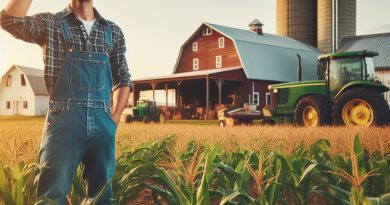Agri Supply Chain: Adapting to Climate Change
Last Updated on February 5, 2024
Introduction
Let’s explore Agri Supply Chain Climate Change.
The agricultural supply chain plays a crucial role in adapting to climate change by ensuring food security and resilience.
In this blog section, we will discuss the key points related to this topic.
The importance of the agricultural supply chain in the context of climate change adaptation
Climate change poses significant challenges to the agricultural sector, including increased risks of extreme weather events, fluctuations in temperature and precipitation patterns, and the spread of pests and diseases.
Diversifying crops and livestock can help mitigate the impacts of climate change.
By cultivating a variety of crops and raising multiple livestock species, farmers can reduce their vulnerability to climate-related risks.
Main points that will be discussed in the blog post
Implementing climate-smart technologies and practices can enhance the efficiency of the agricultural supply chain.
These include precision agriculture, drip irrigation, remote sensing tools, and weather forecasting systems.
Investments in supply chain infrastructure are crucial for ensuring the smooth flow of agricultural products.
This includes upgrading storage facilities, transportation networks, and market linkages to reduce post-harvest losses and increase market access.
Efficient water and energy management, soil conservation practices, and sustainable use of inputs can contribute to climate change adaptation.
These practices not only reduce environmental impact but also enhance the long-term viability of the agricultural supply chain.
Governments and policymakers play a vital role in supporting climate change adaptation in the agricultural supply chain.
By developing and implementing robust policies, regulations, and incentives, they can provide necessary support to farmers and food producers.
In general, the agricultural supply chain is a critical component in adapting to climate change.
By incorporating climate-smart practices, diversifying crops and livestock, and investing in infrastructure, we can ensure food security and build resilience in the face of a changing climate.
Understanding the impacts of climate change on the agri supply chain
How changing weather patterns, extreme events, and temperature fluctuations affect various stages of the supply chain
Climate change is a pressing issue that affects various aspects of our lives, including the agri supply chain.
The changing weather patterns, extreme events, and temperature fluctuations that come with climate change significantly impact the different stages of the supply chain.
The first stage of the supply chain is agriculture, where farmers are at the forefront of facing climate change challenges.
Changing weather patterns, such as irregular rainfall and prolonged droughts, can lead to reduced crop yields and even crop failure.
Extreme events like hurricanes or floods can destroy entire harvests, leaving farmers with significant financial losses.
Temperature fluctuations also affect crop development, potentially leading to suboptimal growth and quality.
The vulnerabilities and challenges faced by farmers, processors, distributors, and retailers
Processors play a crucial role in the supply chain, as they are responsible for transforming raw agricultural products into processed items ready for distribution.
Climate change can disrupt the availability and quality of raw materials, affecting the processors’ ability to maintain consistent production.
Unpredictable crop yields and variations in quality can lead to supply shortages or increased costs.
Moreover, changes in temperature and humidity can impact the shelf life of processed goods, making it challenging for processors to manage inventory effectively.
Distributors serve as the link between processors and retailers, ensuring that products reach their intended destinations.
Climate change vulnerabilities at this stage mainly revolve around transportation.
Extreme weather events can disrupt road and rail networks, making it difficult for distributors to make timely deliveries.
Additionally, variations in temperature can affect the storage and transportation conditions required for perishable products, increasing the risk of spoilage.
These challenges can result in delays, increased transportation costs, and customer dissatisfaction.
Retailers are the final link in the supply chain, connecting products with consumers.
Climate change impacts retailers through increased supply chain costs and potential disruptions in product availability.
Retailers may face difficulties in planning and managing inventory due to unpredictable crop yields and variations in quality.
Extreme events can also damage retail infrastructure, leading to temporary closures or the need for costly repairs.
Ultimately, retailers may struggle to meet consumer demands and maintain profitability.
Basically, climate change poses significant challenges to the agri supply chain.
Understanding the impacts of changing weather patterns, extreme events, and temperature fluctuations is vital for all stakeholders involved.
Farmers, processors, distributors, and retailers must adapt to overcome vulnerabilities and develop resilient strategies to ensure a sustainable and reliable agri supply chain.
Read: Advocacy in Agribusiness: Key Strategies
Implementing climate-smart practices in agriculture
Implementing climate-smart practices in agriculture is crucial for mitigating the impacts of climate change.
These practices not only protect the environment but also ensure the sustainability and productivity of agricultural systems.
The Importance of Adopting Climate-Smart Agricultural Practices
- Enhancing Resilience: Climate-smart practices improve the resilience of agricultural systems to withstand extreme weather events such as droughts, floods, and heatwaves. They reduce vulnerability and minimize crop losses.
- Sustainable Resource Management: Implementing climate-smart techniques promotes efficient use of resources like water, land, and energy. This reduces the environmental footprint of agriculture and ensures long-term resource availability.
- Preserving Biodiversity: These practices preserve biodiversity by maintaining natural habitats, protecting wildlife, and preventing soil degradation. They contribute to ecological balance and sustainable agricultural ecosystems.
- Food Security: Climate change threatens global food security. By adopting climate-smart practices, farmers can sustainably produce higher crop yields, ensuring an adequate food supply for a growing population.
Various Techniques to Adapt to Climate Change
- Conservation Agriculture: Conservation agriculture involves reducing soil disturbance, maintaining soil cover, and diversifying crop rotations. The technique helps retain moisture, improve soil fertility, and reduce erosion.
- Precision Farming: Precision farming utilizes technology such as satellite imagery, GPS, and sensors to optimize farming practices. It enables farmers to monitor and adjust factors like irrigation, fertilization, and pest control based on real-time data, improving efficiency and reducing waste.
- Agroforestry: Agroforestry involves integrating trees into agricultural systems. Trees provide shade, reduce soil erosion, enhance water retention, and sequester carbon dioxide. This technique improves productivity while promoting ecological balance.
- Diversification: Diversifying crop varieties and livestock breeds enhances resilience to climate change. Different crops and breeds have varying tolerances to heat, drought, and diseases, reducing the risk of total crop failure.
- Water Management: Efficient water management techniques like drip irrigation, rainwater harvesting, and water recycling increase water availability for crops. They improve water use efficiency, especially in regions facing water scarcity due to climate change.
- Integrated Pest Management: Integrated pest management (IPM) minimizes the use of chemical pesticides by employing a combination of techniques. This includes biological control, crop rotation, and pest-resistant varieties, reducing both environmental and health risks.
- Soil Management: Practices like organic farming, cover cropping, and composting improve soil health and fertility. Healthy soils have better water and nutrient-holding capacity, enabling crops to withstand extreme climatic conditions.
- Climate Information Services: Access to climate information services helps farmers make informed decisions. Utilizing weather forecasts, climate predictions, and advisory services allows farmers to plan their activities and mitigate the impacts of extreme weather events.
Ultimately, the agriculture sector must adapt to climate change effectively for a sustainable future.
By implementing climate-smart practices like conservation agriculture, precision farming, and agroforestry, farmers can mitigate the impacts of climate change and ensure food security while protecting the environment.
Read: Mastering Agri Finance: Policy Effects
Building Resilience in the Supply Chain
The need for creating resilient supply chains to ensure the availability and affordability of agri products
The effects of climate change on the agriculture supply chain are undeniable.
From extreme weather events to shifting rainfall patterns, farmers and agri-businesses face numerous challenges in ensuring the availability and affordability of agricultural products.
To overcome these challenges, it is crucial to create resilient supply chains that can adapt to and mitigate the impacts of climate change.
Building resilience in the supply chain is not a one-off task; it requires continuous adaptation and innovation.
Governments, agri-businesses, and other stakeholders must collaborate to create an enabling environment for resilient supply chains.
Recognizing the importance of resilient supply chains, policymakers should develop supportive policies and provide incentives for farmers and businesses to adopt climate-smart practices.
This can include financial incentives, technical assistance, and access to affordable credit facilities.
Furthermore, knowledge-sharing platforms and capacity-building programs play a crucial role in enhancing the resilience of the supply chain.
Farmers and agri-businesses should have access to information on climate change adaptation strategies, best practices, and market trends.
Strategies such as diversification of crops, improving infrastructure, and strengthening farmer-producer relationships to enhance resilience
Diversification of Crops
- One strategy to build resilience is the diversification of crops.
- By cultivating a variety of crops, farmers can spread their risks and safeguard against the unpredictability of weather patterns.
- Diversification also helps ensure a stable supply of agri-products, even if one crop fails due to climate-related issues.
Improving Infrastructure
- Investing in infrastructure is essential to strengthen the agility and resilience of the supply chain.
- Efficient transportation systems and storage facilities can reduce post-harvest losses and ensure a steady flow of products to the market.
- Infrastructure improvements should also include the adoption of climate-smart technologies, such as greenhouse farming and precision irrigation systems.
- These technologies not only protect crops from adverse weather conditions but also optimize resource utilization.
Strengthening Farmer-Producer Relationships
- Establishing strong relationships between farmers and producers is vital for building resilience.
- Collaboration and cooperation can help ensure fair prices for farmers and timely availability of inputs, such as fertilizers and seeds.
- Producers can also support farmers by providing training and assistance in adopting climate-smart agricultural practices.
- By working together, farmers and producers can navigate the challenges of climate change and sustain the supply chain.
Essentially, creating resilient supply chains is essential to ensure the availability and affordability of agricultural products in the face of climate change.
Diversifying crops, improving infrastructure, and strengthening farmer-producer relationships are key strategies to enhance resilience.
Collaboration and continuous adaptation are vital to navigate the challenges posed by climate change and sustain the agri supply chain for future generations.
Read: Effective Agri-Export Marketing 101

Utilizing technology for climate adaptation
In today’s rapidly changing climate, the agricultural supply chain faces numerous challenges.
From unpredictable weather patterns to a need for sustainable practices, adapting to climate change is crucial.
One potential solution lies in utilizing technology to improve the efficiency and effectiveness of the agri supply chain.
Improved efficiency and effectiveness
- Technology can streamline various processes within the agri supply chain, resulting in improved efficiency.
- Automated systems can reduce manual errors and save time, ensuring timely delivery of products.
- Real-time data analytics can provide insights on demand, enabling better planning and inventory management.
- Integrating technology across the supply chain helps optimize resource utilization and minimize wastage.
The use of IoT devices, blockchain, and data analytics in optimizing supply chain processes and managing risks associated with climate change
Role of IoT devices
- IoT devices, such as sensors and drones, can monitor and collect data on soil moisture, temperature, and humidity.
- This data can help farmers make informed decisions, optimize irrigation, and minimize water usage.
- Connected devices can also track livestock health, preventing disease outbreaks and improving overall productivity.
- Automated alerts can be sent to farmers, providing early warnings about potential climate-related risks.
Blockchain technology
- Blockchain can improve transparency and traceability within the supply chain, increasing consumer trust.
- Smart contracts can automate payments and agreements, reducing disputes and ensuring fair transactions.
- Supply chain stakeholders can securely share data, enabling better collaboration and risk management.
- Blockchain can track the origin of products, allowing consumers to make informed choices regarding sustainability.
Data analytics in risk management
- Data analytics can help identify climate-related risks and develop strategies to mitigate them.
- Statistical models can predict crop yields, allowing farmers to make informed decisions regarding planting and harvesting.
- Predictive analysis can forecast market demand, enabling supply chain optimization and preventing overproduction.
- Real-time weather data analysis can aid in logistics planning, reducing delays caused by extreme weather events.
Resilience planning
- Technology can aid in developing resilience plans that adapt to climate change scenarios.
- Simulations and modeling can help evaluate the impact of climate change on different stages of the supply chain.
- Contingency plans can be created to address disruptions caused by extreme weather events or changing growing conditions.
- Collaboration platforms can facilitate knowledge sharing and best practices among supply chain stakeholders.
Therefore, technology plays a vital role in improving the efficiency, effectiveness, and resilience of the agri supply chain in the face of climate change.
Leveraging IoT devices, blockchain, and data analytics can optimize processes, manage risks, and promote sustainable practices.
By embracing technological advancements, the agri supply chain can adapt to the changing climate and ensure the availability of food in a more sustainable and secure manner.
Read: Agricultural Loans: Must-Knows for 2024
Policy interventions and financial support
Importance of government policies and regulations in creating an enabling environment for climate adaptation in the agri supply chain
Policies and regulations play a crucial role in facilitating climate adaptation in the agri supply chain.
Government intervention is essential to create an enabling environment that encourages farmers and agribusinesses to adopt climate-friendly practices.
Firstly, policies can address the challenges and vulnerabilities faced by the agri supply chain due to climate change.
One key aspect is the regulation of water resources, as changing rainfall patterns and water scarcity can significantly impact agricultural productivity.
By implementing efficient water management strategies and investing in irrigation infrastructure, governments can help ensure a reliable water supply for farmers.
Furthermore, policies that promote sustainable land management practices can help preserve soil health and mitigate the impact of extreme weather events.
This can include measures like contour plowing, terracing, and cover cropping, which enhance soil fertility and prevent erosion.
Government regulations can also provide guidelines and incentives for the use of climate-smart technologies and practices such as precision agriculture and agroforestry.
These methods maximize productivity while minimizing the environmental footprint of farming operations.
Another important aspect is the promotion of research and development in agriculture to develop innovative solutions for climate change adaptation.
The need for financial support and incentives to encourage farmers and agribusinesses to adopt climate-friendly practices
Government funding and collaboration with research institutions can support the development and dissemination of new technologies and practices.
Financial support is crucial for farmers and agribusinesses to access the resources and technologies necessary for climate adaptation.
Implementing climate-friendly practices often requires investment in new equipment, infrastructure, and training.
Therefore, providing subsidies, grants, and low-interest loans can help overcome financial barriers and incentivize farmers to adopt sustainable practices.
Financial support can also be directed towards promoting the use of renewable energy sources in the agri supply chain.
Encouraging farmers to transition to solar power or biogas for their energy needs can reduce greenhouse gas emissions and decrease dependence on fossil fuels.
Moreover, financial incentives can be provided for the development and adoption of climate-smart insurance schemes.
These schemes can protect farmers against climate-related risks, such as crop failure due to drought or flooding.
By sharing the risk and providing compensation, governments can encourage farmers to invest in climate adaptation measures with confidence.
Lastly, government policies and financial support are indispensable for creating an enabling environment for climate adaptation in the agri supply chain.
Regulations can address climate challenges, promote sustainable practices, and support research and development.
Financial incentives and support can help farmers overcome barriers and adopt climate-friendly technologies and practices.
By working together, governments and the agriculture sector can effectively adapt to climate change and ensure a resilient and sustainable agri supply chain.
Conclusion
Adapting the agri supply chain to climate change is of utmost importance.
By summarizing the key points discussed in this blog post, it is evident that climate change poses significant challenges to the agricultural sector.
However, by implementing effective adaptation strategies, such as using climate-resilient crops, improving water management, and adopting sustainable farming practices, we can ensure food security and sustainability for future generations.
The importance of adapting the agri supply chain to climate change cannot be overstated.
With the increasing frequency and intensity of extreme weather events, it is crucial to recognize the need for resilient supply chains that can withstand and recover from these disruptions.
This will not only safeguard our food production and distribution systems but also protect the livelihoods of millions of farmers around the world.
As individuals, it is essential for us to stay informed about climate change and its impact on agriculture.
By understanding the challenges faced by the agri supply chain, we can actively participate in supporting climate adaptation efforts.
This can include advocating for policy changes, promoting sustainable farming practices in our communities, and supporting initiatives that prioritize climate resilience in the agricultural sector.
Together, we can make a difference and ensure a secure and sustainable food future for all.
Overall, let us recognize the urgency of adapting the agri supply chain to climate change.
By taking action now, we can mitigate the risks, ensure food security, and build a sustainable future for generations to come.


